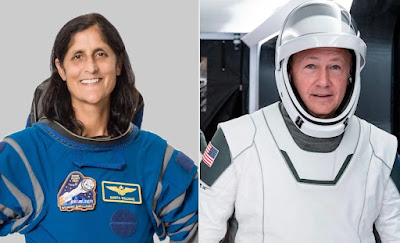 |
| Boeing (left) and SpaceX flight suits - a question of compatability? |
IN THE realm of space exploration, where innovation is often celebrated as much as discovery, one might expect that companies would prioritise the pursuit of standardisation, especially in safety-critical systems.
Yet recent events have highlighted a glaring oversight: a lack of compatibility between spacesuits designed for different spacecraft.
This summer, the issue came into focus when NASA encountered an unexpected challenge during the first crewed test flight of Boeing’s Starliner spacecraft.
Helium leaks and the failure of several thrusters during the docking phase marred the mission, which transported astronauts ‘Butch’ Wilmore and Suni Williams to the International Space Station (ISS).
The resulting uncertainty surrounding Starliner’s ability to return safely raised a critical question: what if they had to return to Earth on a different spacecraft? Could the astronauts use their Boeing-designed spacesuits in a SpaceX Dragon capsule?
The answer, unfortunately, was no. SpaceX and Boeing, two of NASA’s primary commercial partners, developed spacesuits that are incompatible with each other’s spacecraft.
This is not merely a matter of corporate identity or aesthetic preference; it represents a significant and potentially life-threatening oversight.
In a broader context, users in the consumer electronics industry have long been frustrated by a lack of standardisation. An ongoing debate over charging cables for smartphones is one example.
Apple and Android devices operate on different systems, and while this is accepted as a technological difference, many people criticise the incompatibility of charging cables.
The EU has even intervened to push for a standardised charging port, recognising that such differences create unnecessary waste too.
However, unlike the inconvenience of incompatible phone chargers, spacesuit incompatibility could have dire consequences. Astronauts depend on their equipment so the lack of a standardised spacesuit for use across different spacecraft complicates emergency procedures and increases error margins.
On this occasion time was on NASA’s side, but in an actual emergency astronauts finding themselves with the wrong suit for a spacecraft they need urgently to board could prove critical.
NASA’s management of its commercial crew programme provided the perfect opportunity to enforce compatibility standards.
The root of the problem lies in the space industry’s fragmented approach. Commercial entities often develop technologies and systems with little regard for interoperability, seemingly at odds with the spirit of international cooperation that the space industry often prides itself on.
Spacesuits are not merely uniforms; they are critical safety systems and an astronaut’s last line of defence, particularly during launch and re-entry when the risk of cabin depressurisation is highest.
Is it not imperative, therefore, that the industry moves towards a standardised design that can be connected across different spacecraft?
Such arguments are not about stifling innovation or competition, they are about prioritising astronaut safety.
By establishing common standards, similar to those developed by the International Organization for Standardization (ISO) in other industries, the space sector can ensure that astronauts, regardless of the spacecraft they board, have the best possible protection.
The Starliner mission has perhaps unwittingly exposed a critical gap in the industry’s approach. Non-standardised spacesuits are not just a logistical oversight; they are a risk that could jeopardise astronauts’ lives.
As the space industry continues to develop, it is crucial that cooperation extends to the standardisation of safety systems. The small price of compatibility could very well be the difference between life and death in the unforgiving environment of space.
* * *
Editor's note: This commentary by Clive Simpson on spacesuit incompatbility was first published as the Editorial in ROOM Space Journal, issue #35, September 2024. It is republished here with permission.




